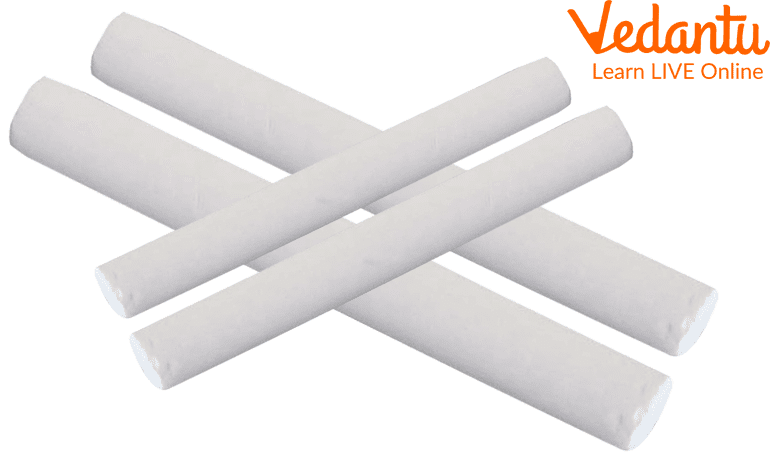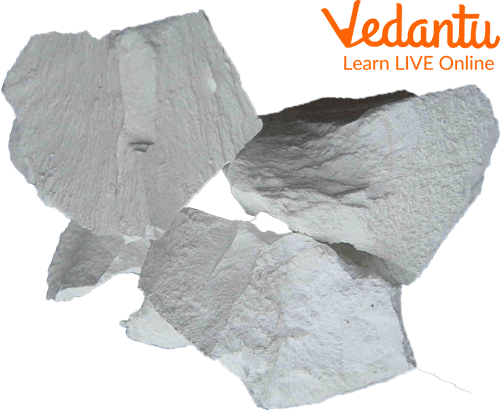




Key Characteristics and Practical Applications of Chalk
Chalk is a soft, whitish stone. It is a kind of limestone. Like different types of limestone, it is produced using animal shells and requires numerous years to shape. It has many purposes. Chalk is present in a lot of northwestern Europe. Britain's well-known white cliff of Dover is produced using chalk. In the United States, chalk stores are tracked down in Arkansas, Louisiana, Texas, and Wyoming.
Chalk is produced using the shells of minuscule ocean animals. At the point when these animals die, their shells sink to the ocean's bottom. Mud covers the shells. Layers of shells and mud gradually develop. Now let’s dive deep and gather more information about chalks.

Chalk
Characteristics of Chalk
A chalk store structures when this material solidifies. The entire cycle can require a long period. Some of the time the water level drops. At the point when this occurs, the chalk can rise over the water's surface. This is the way chalk cliffs are shaped.
The chalk is white or grey. It is additionally permeable.
This implies that rain and other water can get into it. After numerous years, heaps of rain can gather in a space of chalk. A few urban communities get their drinking water from this collection of water. Oil and petroleum gas additionally gather in chalk. Chalk is highly resistant to weathering. It can stock up a large volume of groundwater as it is well joined. Nowadays different colours of chalks are also available which are commonly used in schools and coaching centres.
Chalk is a non-clastic carbonate sedimentary stone that is a type of limestone composed of the mineral calcite

Limestone
Uses of Chalk
Chalk is extremely helpful. Powdered chalk is utilized in toothpaste and stomach medications. Chalk is additionally used to make such items as paint, elastic, and concrete.
Craftsmen draw with chalk. Instructors compose on boards with chalk. Be that as it may, the chalk utilized by craftsmen and educators is sometimes false chalk. It is frequently blended in with different fixings, or it is produced using a mineral called gypsum.
The first encounter with people with chalk happened mostly in schools where the teacher writes with chalk on a blackboard. This mineral chalk readily leaves particles allowing them to stick loosely on rough surfaces.
Coloured chalk, pastel chalk and sidewalk chalk are used to draw on sidewalks, streets and driveways. Chalk is also a source of quicklime by thermal decomposition. Small doses of chalk can be used as an antacid.
Chalk is also prepared with a fully controlled grain size for very fine polishing of metals, which is known as polishing chalk. It is likewise utilized as "slate chalk" for composing and drawing on different types of surfaces.
Harmful Effects of Chalk
Since chalk is made of calcium carbonate and calcium sulphate, it can cause adverse effects on the health of humans. Kids who are exposed to chalk in classrooms can complain of eye irritation, skin irritation, respiratory tract irritation, mucous membrane irritation etc.
Chronic exposure to chalk can cause lung problems and liver damage as well. Some kids might eat and can develop an addiction which can lead to many health problems such as nausea, vomiting, constipation etc. Eating chalk can often disrupt the digestive system and can damage internal organs as well.
Summary
So, now we know what is chalk. Chalk is a white, permeable, sedimentary carbonate rock. It is a type of limestone made out of the mineral calcite and framed profoundly under the ocean by the pressure of minuscule fish that had settled on the ocean bottom. Chalk is normal all through Western Europe, where stores underlie portions of France, steep bluffs are in many cases seen where they meet the ocean, for example, the Dover precipices on the Kent shore of the English Channel.
Chalk is mined for use in industry, for quicklime, blocks, and manufacturer's clay, in farming, and for bringing pH up in soils with high causticity. With this we have come to an end of our article about chalk where we have discussed its uses, characteristics as well as harmful effects. In case of any other doubts, feel free to ask in the comments.
FAQs on Chalk: Definition, Uses, and Impact
1. What is chalk and where does it come from?
Chalk is a soft, white, porous type of sedimentary rock. It is a form of limestone that is naturally created from the fossilised skeletons of tiny marine organisms, such as plankton called coccolithophores. Over millions of years, these microscopic shells accumulated on the ocean floor, compressing and hardening to form the chalk deposits we see today.
2. What is chalk made of chemically?
The primary chemical component of natural chalk is calcium carbonate, with the chemical formula CaCO₃. The purest varieties of chalk rock can be up to 99% calcium carbonate. The chalk used in classrooms, however, may sometimes be made from another mineral called gypsum (calcium sulfate) to reduce dust.
3. What are the main uses of chalk in our daily lives?
Chalk has several common uses beyond the classroom. These include:
Art and Drawing: Used by artists for sketching and by children as sidewalk chalk.
Sports: Gymnasts, rock climbers, and weightlifters use chalk powder to absorb sweat and improve their grip.
Industry: Powdered chalk is used as a filler in products like paint, rubber, and putty.
Agriculture: Farmers use chalk to treat acidic soil and improve conditions for crops.
4. How is the chalk we use in classrooms different from natural chalk rock?
Natural chalk is a rock mined directly from the earth. In contrast, classroom chalk is a manufactured product. While some blackboard chalk is made from pulverised natural chalk, many modern 'dustless' chalks are actually made from gypsum (calcium sulfate). This is done because gypsum produces heavier particles that fall directly to the ground instead of floating in the air, making it cleaner to use.
5. Why does chalk feel so soft and leave a mark so easily?
Chalk's softness is due to its structure. It is made of microscopic, loosely packed particles of calcite (from the ancient fossils). These particles are not strongly bonded together. When you press a piece of chalk against a surface like a blackboard, these weak bonds break, and a layer of the fine particles easily rubs off and sticks to the surface, leaving a visible mark.
6. Is chalk a type of clay?
No, chalk is not a type of clay. While both are natural materials from the earth, they have different compositions. Chalk is a type of limestone, primarily made of calcium carbonate. Clay, on the other hand, is composed of a variety of silicate minerals. Chalk is a biogenic rock (formed from living organisms), while clay is typically formed from the weathering of other rocks.
7. Is it safe for a student to eat chalk? Why or why not?
No, it is not safe to eat chalk. Although classroom chalk is generally considered non-toxic if a very small piece is accidentally swallowed, intentionally eating it is harmful. It can lead to stomach aches, constipation, or vomiting. Chalk has no nutritional value and is not a food item. The desire to eat non-food items like chalk is a condition called pica, which may indicate a nutrient deficiency.
8. What happens if you drop a piece of chalk into a glass of vinegar?
If you place a piece of chalk in vinegar, you will see bubbles and fizzing. This is a chemical reaction. The calcium carbonate in the chalk reacts with the acetic acid in the vinegar. This reaction breaks down the chalk and produces carbon dioxide gas, which are the bubbles you observe. This simple experiment demonstrates that chalk is a carbonate rock.









